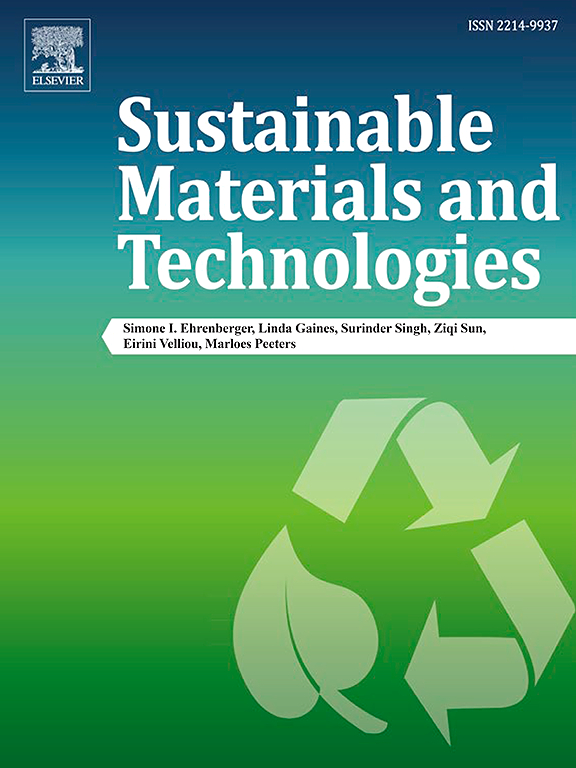一种新的两性离子色谱法从非常规资源中分离锂
IF 8.6
2区 工程技术
Q1 ENERGY & FUELS
引用次数: 0
摘要
锂(Li)是清洁能源技术的关键元素,因此,全球锂需求一直在迅速增长。因此,为了满足锂需求并保持供应链的稳定性,开发高效的锂提取技术至关重要,该技术可以开采非常规锂资源,如地热盐水和内陆盐水流。然而,由于锂浓度低、Li/Na、Li/Mg或Li/Ca比例低以及饲料成分复杂,从这些资源中回收锂具有挑战性。为了解决这个问题,我们引入了一种新的直接锂萃取(DLE)工艺,使用两性离子色谱(ZIC)从其他盐中分离锂。由于盐在水洗脱下在ZIC上被分割,不需要化学试剂,Li的分离不受吸附容量的限制。制备了13种不同的两性离子树脂,研究了不同ZI基团上的盐保留情况,并筛选出了有效分离锂的吸附剂。结果表明,孔隙大小和ZI构型对盐潴留有协同影响。采用羧甜菜碱(QAC3CA)吸附剂进行多组分分离,结果表明Li与二价盐和Na的分离选择性分别为1.8和1.9。虽然选择性相对较低,但在实际卤水试验中,从Ca和Mg中分离出Li的收率为79.2%,显示出连续工艺实现高产、高产的潜力。模拟研究表明,盐洗脱机理与水化反应能和阳离子的有效水化半径有关。本文章由计算机程序翻译,如有差异,请以英文原文为准。

A novel zwitterionic chromatography approach to separate lithium from unconventional resources
Lithium (Li) is a key element for clean energy technologies, and, accordingly, the global lithium demand has been increasing rapidly. Therefore, to meet the Li demand and maintain supply chain stability, it is critical to develop efficient lithium extraction technologies that allow exploitation of unconventional lithium resources, such as geothermal brines and inland brine streams. However, the recovery of Li from these resources is challenging due to low Li concentration, low ratios of Li/Na, Li/Mg, or Li/Ca, and complex feed compositions. To address this, we introduced a new Direct Lithium Extraction (DLE) process using Zwitterionic Chromatography (ZIC) to separate Li from other salts. Since salts are partitioned on ZIC under water elution, no reagent chemicals are needed, and the Li separation is not limited by the adsorption capacity. We prepared 13 different zwitterionic (ZI) resins to investigate the salt retention on various ZI groups and then screened out promising sorbents for efficient Li separation. It was found that salt retention was synergistically affected by the pore size and ZI configurations. Using carboxybetaine (QAC3CA) sorbents, multicomponent separations showed that Li can be partitioned from divalent salts or Na with selectivities of 1.8 or 1.9, respectively. Although the selectivity is relatively low, in real brine tests, Li was separated from Ca and Mg with 79.2 % yield, showing the potential for a continuous process to achieve high productivity and high yield. Simulation studies suggest the salt elution mechanism is related to the hydration reaction energy and the effective hydrated radius of cations.
求助全文
通过发布文献求助,成功后即可免费获取论文全文。
去求助
来源期刊

Sustainable Materials and Technologies
Energy-Renewable Energy, Sustainability and the Environment
CiteScore
13.40
自引率
4.20%
发文量
158
审稿时长
45 days
期刊介绍:
Sustainable Materials and Technologies (SM&T), an international, cross-disciplinary, fully open access journal published by Elsevier, focuses on original full-length research articles and reviews. It covers applied or fundamental science of nano-, micro-, meso-, and macro-scale aspects of materials and technologies for sustainable development. SM&T gives special attention to contributions that bridge the knowledge gap between materials and system designs.
 求助内容:
求助内容: 应助结果提醒方式:
应助结果提醒方式:


